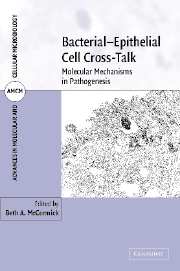Book contents
- Frontmatter
- Contents
- List of contributors
- Part I Introduction to the host and bacterial pathogens
- Part II Bacterial cell biology and pathogenesis
- Part III Host cell signaling by bacteria
- Part IV Exploitation of host niches by pathogenic bacteria: mechanisms and consequences
- 11 Lung infections
- 12 Interaction of Helicobacter pylori with the gastric mucosa
- 13 Interactions of enteric bacteria with the intestinal mucosa
- 14 Uropathogenic bacteria
- Index
- Plate section
- References
11 - Lung infections
from Part IV - Exploitation of host niches by pathogenic bacteria: mechanisms and consequences
Published online by Cambridge University Press: 12 August 2009
- Frontmatter
- Contents
- List of contributors
- Part I Introduction to the host and bacterial pathogens
- Part II Bacterial cell biology and pathogenesis
- Part III Host cell signaling by bacteria
- Part IV Exploitation of host niches by pathogenic bacteria: mechanisms and consequences
- 11 Lung infections
- 12 Interaction of Helicobacter pylori with the gastric mucosa
- 13 Interactions of enteric bacteria with the intestinal mucosa
- 14 Uropathogenic bacteria
- Index
- Plate section
- References
Summary
INTRODUCTION
The airway epithelium represents a primary site for the introduction and deposition of potentially pathogenic microorganisms into the body through inspired air. The ciliated epithelium lining the airways possesses several mechanisms to prevent colonization by inhaled bacteria and, despite repeated exposures to a wide variety of organisms, the lower respiratory tract usually remains sterile. The airway is defined anatomically as the upper respiratory tract, which includes the nasal sinuses and the nasopharynx, and the lower respiratory tract, which begins at the larynx and continues to the trachea, before dividing into the smaller airways until they reach the alveoli. The luminal surface of the airways is lined by a layer of epithelial cells. In the conducting airways, these cells are pseudostratified columnar epithelial cells, which become simple cuboidal epithelium as the branches extend to the alveoli (Diamond et al., 2000). The respiratory epithelium is an essential barrier that features tight intercellular apical junctions between the cells, a superficial liquid layer or film that contains mucous-gland and goblet-cell secretions, immunoglobulins, and lysozyme, components that are propelled and cleared by cilia.
INNATE HOST DEFENSES AGAINST BACTERIAL LUNG PATHOGENS
In the upper airways, the nose functions as a filter by trapping large particulate matter (>10 μm) in nasal hair or on the surface of the turbinates and septum. Smaller particles, including bacteria ranging in size from 2 μm to 10 μm, are inhaled and deposited in the lower conducting airways.
- Type
- Chapter
- Information
- Bacterial-Epithelial Cell Cross-TalkMolecular Mechanisms in Pathogenesis, pp. 301 - 326Publisher: Cambridge University PressPrint publication year: 2006



